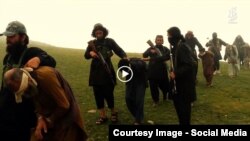As the self-declared caliphate of the Islamic State (IS) crumbles in Iraq and Syria, Afghanistan is bracing for an influx of radical fighters from the Middle East.
Kabul in particular is expecting to face battle-hardened Central Asian militants who form a sizeable part of the core IS military machine in Iraq and Syria, where the group is under tremendous pressure from international and Syrian forces.
After losing its seat in Iraq, Mosul, this month, IS now faces the demise of its territorial control over Raqqa, its capital, which is surrounded by various hostile forces. Such an eventuality will force its international jihadist cadres to disperse.
“Porous borders in the region might help some Central Asian IS fighters to return to our country,” a Middle East-based Afghan diplomat tasked with tracking IS activities in the region told RFE/RL’s Gandhara website.
The diplomat, who requested anonymity because he is not authorized to speak to the media, monitors resources and manpower being sent to his country’s conflict from Middle Eastern nations.
He said it was difficult to predict the exact number of militants Afghan authorities expect to join the fighting in their country.
“Daesh fighters are already responsible for some of the instability in northern Afghanistan after they moved there from the border region between Afghanistan and Pakistan [in 2014],” he said, using the local name for IS.
The diplomat was referring to Salafist fighters from Central Asia who formerly allied with Taliban groups in Afghanistan and Pakistan. Most were affiliated with the Islamic Movement of Uzbekistan (IMU) or its various splinter groups.
A Pakistani military offensive in 2014 targeting their North Waziristan stronghold along the country’s western border with Afghanistan dispersed them into various Afghan provinces while some joined IS in the Middle East.
Western specialists say the IMU diaspora and new recruits from Central Asia and Russia have provided IS with thousands of fighters in Iraq and Syria.
The Afghan diplomat says he now worries that after the demise of IS in Syria, the fighters will find ways to join their comrades already active in Afghanistan.
“They will pose a great danger if they get to Afghanistan’s border with Central Asian countries,” he said. “This is a major threat not only to Afghanistan but also to its Central Asian neighbors. Turkmenistan in particular is vulnerable.”
Afghan officials near the country’s western borders with Turkmenistan agree.
Baz Mohammad Dawar, the governor of Darzab, a rural district in northern Jowzjan Province, has seen Daesh establish a firm foothold in the region this year.
He says a local Taliban commander, Qari Samad, paved the way for IS to establish a local presence after he switched allegiance to the radical group.
“Most of the IS trainers now active in Darzab are Uzbekistanis. They are training children and have shut down schools,” he said. “The strategic region of Darzab is set to turn into another Achin in the north if a robust offensive fails to prevent the militants from building a firm foothold.”
Since early 2015, Achin -- a mountainous district in Afghanistan’s eastern province of Nangarhar on the Pakistani border -- has served as the de-facto capital of Khorasan Province, a local affiliate of IS in Afghanistan and Pakistan.
Dawar says IS’s Central Asian fighters are already paving the way for their arrival in Afghanistan.
“Last month, some delegations of IS operatives visited from Iraq and Syria. They were mostly Uzbekistanis and were tasked with coordinating between the two branches of Daesh,” he said. “We have reports that one of these delegations, which comprised four people, was nabbed by Taliban commander Mullah Baqi, who killed them in the district of Kohistan [in neighboring Faryab Province].”
According to the Afghanistan Analysts Network, Central Asian fighters make up less than a third of IS’s fighting force in Afghanistan. They have to compete against a large number of Pakistani fighters and leaders. Following the directions of central IS, the Central Asian fighters recently agreed with the Pakistanis to form a 40-member shura, or council, to appoint leaders.
“[IS] is also facing emerging internal differences, mainly between the more radical Central Asian fighters and the locally better entrenched and therefore more powerful Pakistani leaders,” noted a recent report by the group.
The arrival of Central Asian IS fighters from Syria and Iraq will ultimately help their bid for leadership of the group and pave their way to project power into their home countries bordering Afghanistan.
“If they succeed in establishing a foothold in Afghanistan, they will become a major headache for our government alongside the Taliban,” the Afghan diplomat noted.







